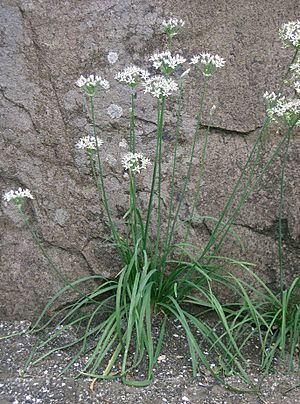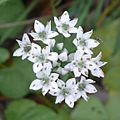Garlic chives facts for kids
Quick facts for kids Garlic chives |
|
|---|---|
 |
|
| Flowering garlic chives | |
| Scientific classification | |
| Genus: |
Allium
|
| Species: |
tuberosum
|
| Synonyms | |
|
Synonymy
Allium angulosum Lour. 1790, illegitimate homonym not L. 1753
Allium argyi H.Lév. Allium chinense Maxim 1859, illegitimate homonym not G.Don 1827 Allium clarkei Hook.f. Allium roxburghii Kunth Allium sulvia Buch.-Ham. ex D.Don Allium tricoccum auct. non Blanco Allium tuberosum Roxb. 1832, illegitimate homonym not Rottler ex Spreng. 1825 Allium tuberosum f. yezoense (Nakai) M.Hiroe Allium uliginosum G.Don Allium yesoense Nakai Allium yezoense Nakai Nothoscordum sulvia (Buch.-Ham. ex D.Don) Kunth |
|
Allium tuberosum is a plant often called garlic chives. You might also hear it called Oriental garlic or Chinese chives. This plant comes from the Shanxi province in China. People grow it in many parts of Asia and all over the world. It has also spread and now grows wild in many places.
Contents
What Garlic Chives Look Like
Garlic chives are a type of perennial plant. This means they grow back year after year. They grow in clumps from a small, tough bulb that is about 10 millimeters (0.4 inches) wide.
Unlike onions or garlic, garlic chives have flat, strap-shaped leaves. These leaves are about 1.5 to 8 millimeters (0.06 to 0.3 inches) wide. The plant also grows tall stalks, usually 25 to 60 centimeters (10 to 24 inches) high. At the top of these stalks, you'll see many small white flowers grouped together in a round shape.
Garlic chives spread slowly in clumps. They also grow easily from seeds. In warmer places, like USDA zone 8, the leaves can stay green all year. But in colder areas (USDA zones 4 to 7), the leaves and stalks die back in winter. They then grow new shoots from their roots in the spring.
The taste of garlic chives is more like garlic than regular chives.
How Garlic Chives Are Named
The plant Allium tuberosum was first described by a scientist named Johan Peter Rottler. Its official name was later published by Curt Polycarp Joachim Sprengel in 1825. This plant belongs to a group called Allium, which includes onions and garlic.
Where Garlic Chives Grow
Garlic chives originally came from the steppes (grassy plains) of Siberia, Mongolia, and North China. Today, people grow them widely, and they have also spread into the wild.
You can find them growing wild in some parts of the United States. These include states like Illinois, Michigan, Ohio, and Wisconsin. They are thought to be even more common in North America. This is because their seeds are easy to get, and the plant grows very quickly. Garlic chives are also found across much of Europe. In some other parts of the world, they are considered an invasive species. This means they can spread fast and take over areas.
Growing Garlic Chives
People often grow garlic chives in gardens because they are pretty. They are also known for blooming later than most other Allium plants. Garlic chives can handle cold weather, growing well in USDA zones 4–10 (which means temperatures from about -30 to +35 degrees Fahrenheit).
It's easy to grow garlic chives in many different conditions. They can spread quickly from their seeds. You can also grow more plants by dividing their clumps.
Farmers have created different types of garlic chives. Some types are grown for their leaves, like 'Shiva'. Others are grown for their flower stems, such as 'Nien Hua'. In Asia, people mostly grow them for cooking. In North America, they are often grown more as ornamental plants (for their beauty). 'Monstrosum' is a very large type grown for its looks.
How People Use Garlic Chives
| Garlic chives | |
|---|---|
 |
|
| Chinese name | |
| Chinese | 韭菜 |
| Hanyu Pinyin | jiǔ cài |
| Wade–Giles | chiu3 ts'ai4 |
| Romanization | kíu chhoi |
| Yale Romanization | gáu choi |
| Jyutping | gau2 coi3 |
| Hokkien POJ | kú chhài |
| Tâi-lô | kú tshài |
| Dunganese name | |
| Dungan | джуцей |
| Vietnamese name | |
| Vietnamese | hẹ |
| Thai name | |
| Thai | กุยช่าย |
| RTGS | kuichai |
| Korean name | |
| Hangul | 부추 |
| Revised Romanization | buchu |
| McCune–Reischauer | puch'u |
| Japanese name | |
| Kanji | 韮 |
| Kana | にら/ニラ |
| Revised Hepburn | nira |
| Kyrgyz name | |
| Kyrgyz | жусай |
Garlic chives are used in many ways. They are grown as pretty garden plants. Their cut and dried flowers are also used for decoration. People use them as a cooking herb and in some traditional medicines. For hundreds of years, people in East Asia have grown garlic chives for cooking. The flat leaves, stalks, and unopened flower buds are all used to add flavor to food.
Sometimes, garlic chives are "blanched." This means they are grown in the dark after being cut. This makes their leaves turn white-yellow and gives them a milder flavor.
In China
In China, the leaves are used like scallions or chives. They are often added to stir-fry dishes. Garlic chives are also a main ingredient in dumplings, often with eggs, shrimp, or pork. A Chinese flatbread, similar to a scallion pancake, can be made with garlic chives. They are also used in yi mein noodle dishes. The flowers can be fermented to make garlic chive flower sauce. When grown in the dark, they are called jiuhuang and used in many stir-fry recipes.
In India
In Manipur and other northeastern parts of India, garlic chives are grown. They are used instead of garlic and onion in cooking. In Manipuri, they are called maroi nakuppi.
In Japan
In Japan, the plant is known as nira. It is used for both garlic-like and sweet flavors. You can find it in miso soups, salads, and stir-fries with eggs. It's also used in Japanese dishes like gyōza dumplings and fried liver.
In Central Asia
In countries like Kazakhstan and Kyrgyzstan, garlic chives are known by names similar to their Chinese name. They were brought there by Dungan farmers. People use them in cooking, sometimes as a filling for manty (dumplings), samsa (pastries), and laghman (noodles).
In Korea
In Korean cuisine, garlic chives are called buchu (부추). They are used in many ways. You can eat them fresh as namul (seasoned vegetables). They are also pickled to make kimchi and jangajji. People also pan-fry them in buchimgae (pancakes). Garlic chives are often served with gukbap (soup with rice). They are also a common ingredient in mandu (dumplings).
-
Buchu-jeon (garlic chive pancakes)
-
Buchu-geotjeori (garlic chive fresh kimchi)
-
Buchu-kimchi (garlic chive kimchi)
-
Chueo-tang (loach soup) served with garlic chives
-
Jaecheop-guk (jaecheop clam soup) with chopped garlic chives in it
In Nepal
In Nepal, cooks make a curried vegetable dish. It uses potatoes and garlic chives, and is called dunduko sag.
In Vietnam
In Vietnam, garlic chive leaves are called hẹ. They are cut into short pieces and used as the only vegetable in a broth with sliced pork kidneys.
Gallery
See also
 In Spanish: Allium tuberosum para niños
In Spanish: Allium tuberosum para niños











